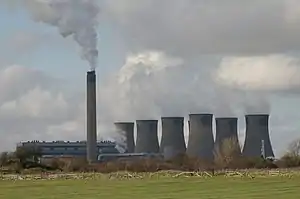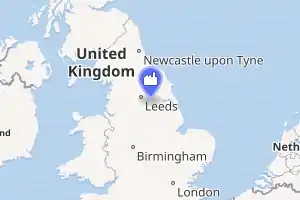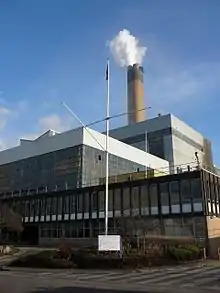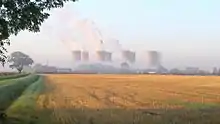Eggborough power station
Eggborough power station is a large decommissioned coal-fired power station in North Yorkshire, England, which was capable of co-firing biomass. It is situated on the River Aire, between the towns of Knottingley and Snaith, deriving its name from the nearby village of Eggborough. The station had a generating capacity of 1,960 megawatts, enough electricity to power 2 million homes, equivalent to the area of Leeds and Sheffield.[1] The station closed in September 2018, but there are plans to replace it with a 2,500 megawatt gas power plant.[2]
| Eggborough power station | |
|---|---|
 Eggborough Power Station Viewed from the south in February 2007 | |

| |
| Country | England |
| Location | Knottingley |
| Coordinates | 53.7116°N 1.1269°W |
| Status | Decommissioned |
| Construction began | 1962 |
| Commission date | 1967–70 |
| Decommission date | 2018 |
| Operator(s) | Central Electricity Generating Board (1967—1990) National Power (1990—2000) British Energy (2000—2010) Eggborough Power ltd (2010—present) |
| Thermal power station | |
| Primary fuel | Coal |
| Secondary fuel | Fuel oil (gas turbines) |
| Site area | 400 acres (162 ha) |
| Power generation | |
| Units operational | 4 × 500 MW |
| Nameplate capacity | 1,960 MW |
| External links | |
| Website | www |
| Commons | Related media on Commons |
grid reference SE576242 | |
The station began generating power in 1967,[3][4] making use of nearby coal-reserves. It was built for, and initially operated by the Central Electricity Generating Board.
History

Construction
Eggborough power station was first proposed alongside Ferrybridge "C" power station in April 1961.[5] Construction was authorised in early 1962,[6] which included the demolition of Sherwood Hall.[7] The architect was George Hooper of Sir Percy Thomas & Son. Large expanses of aluminium cladding and dark glazing were intended to give 'a cool and defining architectural expression that subtly contrasted with the warm concrete towers and the black-capped chimney'.[8] Construction of the station was completed in 1967.[5]
The station was designed to accommodate four 500 megawatt (MW) coal-fired pulverised fuel units, giving the station a total electrical output of 1,960 MW. The first of these units were connected to the national grid in February 1967.[6] Units 2, 3 and 4 had all been commissioned by 1970.
The station was officially opened by Brigadier Kenneth Hargreaves on the 18th September 1970,[9][10] once all units had been commissioned.
Specification
There were four boilers rated at 550 kg/s, steam conditions were 158.58 bar at 568/568°C reheat.[11] Units 3 and 4 had Flue Gas Desulphurisation equipment installed, which reduced the units' emissions of Sulphur Dioxide by around 90%.[1][12]
There were 3 × 17.5 MW auxiliary black start Rolls Royce Olympus gas turbines on the site, these were first commissioned in May 1967.[11]
Eggborough power stations were supplied with fuel via a 1½ mile branch line off the Wakefield and Goole Line. Rail facilities include a west-facing junction on the Goole line, two coal discharge lines (No. 1 and No. 2), gross- and tare-weight weighbridges, a hopper house, a limestone unloading line and an oil discharge line.[13][14]
The eight cooling towers are arranged in two rows of four located to the west of the power station building. There is a single 200 m (660 ft) tall chimney located to the north of the main building. This was constructed in 1966.[15] The electrical switching station was located to the south of the main building.[16]
In 2005 a retrofit turbine upgrade was carried out to increase the station's efficiency and flexibility by improving part-load and two-shift operation.[10]
The station employed around 300 people, as well as contractors.[1]
Ash disposal
Alongside Ferrybridge Power Stations, Eggborough used to pump ash from the incineration process to a piece of land south of the railway line, the M62 and the Aire and Calder Navigation called Gale Common Ash Disposal.[17] The area covered 0.58 square miles (1.5 km2) and was landscaped by Brenda Colvin into a hill with contours (she was said to have been inspired by Maiden Castle Hill Fort in Dorset). The hill reaches a height of 160 feet (50 m) and stands out amongst the rather flat landscape of this part of North Yorkshire.[18][19]
Ownership
The station was built for, and initially operated by, the Central Electricity Generating Board. The station became the property of National Power on privatisation of the industry in 1990.
British Energy bought Eggborough Power Station, as its only coal-fired power station, in 2000 to provide a more flexible power production facility alongside its nuclear power stations to reduce penalty charge risks from the New Electricity Trading Arrangements introduced in March 2001. The purchase of Eggborough occurred at the peak of the market for power stations, and in 2002 the value of the station was written down by half.[20]
At the beginning of 2009, Électricité de France (EDF) purchased British Energy. In August 2009, it became apparent that the station's lenders had the option to buy the station the following April, to comply with commitments made to the European Commission when agreeing the acquisition of British Energy.[21] On 1 April 2010, EDF transferred Eggborough to the plant's bondholders.[22]
In November 2014 it was announced, that power station was to be acquired by Czech Republic-based Energetický a průmyslový holding.[23] The acquisition was finalised January 2015.[24]
Closure
In September 2015 the owners announced the plant was expected to stop producing electricity by the end of March 2016. However less than two months before the closure, in February 2016 it was announced that the plant would continue to operate for at least another twelve months through to March 2017.[24][25][26]
On 1 August it was announced that a further unit would be available to run commercially from mid September 2016.[27] Units 1 & 2 will generate for National Grid under the Supplementary Balance Reserve contracts providing 775 MW.[28] Unit 4 returned to commercial operation on 16 September 2016 to generate 440 MW into the wholesale market following six months of deep maintenance.[29]

On 26 August 2016 Eggborough Power Limited (EPL) proposed to develop a new Eggborough Gas-Fired Power Station[30] on the site of its existing coal-fired power station. The new power station will be a combined cycle gas turbine or ‘CCGT’ plant with three units generating 2,000 MW. Outline plans for the new development, which should be completed by 2022, involve demolishing the coal fired site and building a new gas connection. The plans are available on the National Infrastructure Planning web site and summarised on Eggborough's own website.[31]
On 2 February 2018 it was announced that Eggborough would close the following September.[32] Eggborough power station stopped generating and de-synced on 23 March 2018. Generator 4 was the last operational unit and was declared unavailable at 02:00.[33]
Use in media
In late 2018 the decommissioned station was used as a filming location for the Fast and the Furious film, Hobbs & Shaw.[34]
See also
References
- "Modern Apprenticeship in Engineering at Eggborough Power Station" (PDF). British Energy. Archived from the original (PDF) on 7 August 2011. Retrieved 3 November 2009.
- "New gas-fired energy plant planned". BBC News. 20 September 2018. Retrieved 24 September 2018.
- "Power Stations in the United Kingdom (operational at the end of May 2004)" (PDF). Retrieved 29 September 2020.
- "Eggborough Power - EP Power Europe". Retrieved 30 May 2020.
- Clarke, Jonathan (2013). High merit: existing English post-war coal and oil-fired power stations - Appendix 1. London: Historic England. pp. 2 & 13.
- "Eggborough celebrates a million hours of power". energylivenews.com. 25 November 2013. Retrieved 30 May 2020.
- "Eggborough CCGT Project - Environmental Impact Assessment: Scoping Report" (PDF). Retrieved 29 September 2020.
- Clarke, Jonathan (2013). High merit: existing English post-war coal and oil-fired power stations in context. London: Historic England. p. 17.
- "Official opening of Eggborough power station in 1970". Pontefract and Castleford Express. Retrieved 29 September 2020.
- "Eggborough - Our History". March 2013. Archived from the original on 23 September 2017. Retrieved 20 March 2013.
- Handbook of Electricity Supply Statistics 1989. London: The Electricity Council. 1990. pp. 4 & 8. ISBN 085188122X.
- "Eggborough". British Energy. Archived from the original on 27 January 2013. Retrieved 13 June 2008.
- Jacobs, Gerald (1988). Eastern and Anglia Regions Track Diagrams. Exeter: Quail. pp. 21B. ISBN 0900609559.
- Brailsford, Martyn (2016). Railway Track Diagrams Book 2: Eastern. Frome: Trackmaps. pp. 10B. ISBN 9780954986681.
- "Electricity Supply in the UK: A chronology". Electricity Council. 1987. p. 92.
- Sheail, John (1991). Power in Trust. Oxford: Clarendon Press. p. 214. ISBN 0-19-854673-4.
- "Project Overview - Gale Common". Retrieved 29 September 2020.
- Historic England. "Monument No. 1403783 Gale Common Ash Disposal (1403783)". PastScape. Retrieved 25 September 2017.
- "High merit post war coal & oil fired power stations" (PDF). historicengland.org.uk. Appendix 1. p. 2. Retrieved 25 September 2017.CS1 maint: location (link)
- "Risk Management: The Nuclear Liabilities of British Energy plc" (PDF). National Audit Office. 6 February 2004. p. 24. Retrieved 13 June 2008.
- Freke, Tom; Pamuk, Humeyra; Stonestreet, John (27 August 2009). "Hedge funds to buy EDF's Eggborough power plant". reuters.com. Retrieved 22 February 2011.
- Airlie, Catherine (1 April 2010). "EDF Transfers Eggborough Plant to Bondholders After Buying British Energy". Bloomberg. Retrieved 7 July 2010.
- Žižka, Jan (4 November 2014). "Křetínský koupil elektrárnu v Británii. Má výkon jako Temelín" (in Czech). lidovky.cz. Retrieved 5 November 2014.
- "UK's coal-fired Eggborough power plant may close in March 2016". Reuters. 2 September 2015. Retrieved 2 September 2015.
- "Eggborough set to close in March 2016". utilityweek.co.uk. 2 September 2015. Retrieved 2 September 2015.
- "Reprieve for threatened Eggborough Power Station". BBC News. 8 February 2016. Retrieved 11 March 2016.
- "3 Unit running at Eggborough Power Ltd". www.eggboroughpower.co.uk. Retrieved 3 August 2016.
- "Eggborough SBR Operational Information | National Grid". www2.nationalgrid.com. Retrieved 3 August 2016.
- "Eggborough Power Ltd - REMIT Data". www.eggboroughpower.co.uk. Retrieved 3 August 2016.
- "Eggborough CCGT Project – Proposal to develop a new gas-fired power station". www.eggboroughccgt.co.uk. Retrieved 26 August 2016.
- "Eggborough CCGT | National Infrastructure Planning". infrastructure.planninginspectorate.gov.uk. Retrieved 26 August 2016.
- "Eggborough power station to close with loss of 170 jobs". BBC News. 2 February 2018. Retrieved 4 February 2018.
- "Eggborough Power station REMIT data". Retrieved 24 March 2018.
- "Hobbs and Shaw to film in Eggborough village". BBC News. 8 November 2018. Retrieved 29 September 2020.
Further reading
- Cooke, B.W.C., ed. (November 1966). "Twenty–Million Tons a Year: Coal supply by rail to three Yorkshire power stations". Railway Magazine. Vol. 662 no. 787. pp. 617–620.
External links
| Wikimedia Commons has media related to Eggborough Power Station. |
